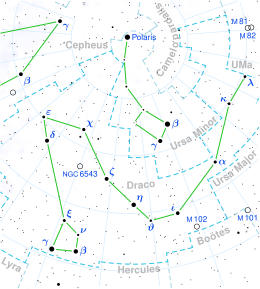| Observation data Epoch J2000 Equinox J2000 | |
|---|---|
| Constellation | Draco |
| Right ascension | 18h 21m 03.38255s [1] |
| Declination | +72° 43′ 58.2518″ [1] |
| Apparent magnitude (V) | 3.570 [2] |
| Characteristics | |
| Spectral type | F7V / K0V [3] |
| U−B color index | −0.06 [4] |
| B−V color index | +0.49 [4] |
| Variable type | Suspected [5] |
| Astrometry | |
| Radial velocity (Rv) | +32.4 [2] km/s |
| Proper motion (μ) | RA: +531.21 [1] mas/yr Dec.: −349.71 [1] mas/yr |
| Parallax (π) | 120.05±0.15 mas [3] |
| Distance | 27.17 ± 0.03 ly (8.33 ± 0.01 pc) |
| Absolute magnitude (MV) | 4.04 [2] |
| Orbit [6] | |
| Primary | χ Dra Aa |
| Companion | χ Dra Ab |
| Period (P) | 0.7680599±0.000061 yr |
| Semi-major axis (a) | 0.1244±0.0011″ |
| Eccentricity (e) | 0.428±0.012 |
| Inclination (i) | 74.42±0.58° |
| Longitude of the node (Ω) | 230.30±0.51° |
| Periastron epoch (T) | 1,984.8324±0.0026 |
| Argument of periastron (ω) (secondary) | 119.3±1.1° |
| Details | |
| χ Dra Aa | |
| Mass | 1.029±0.026 [3] M☉ |
| Radius | 1.20±0.09 [3] R☉ |
| Luminosity | 1.86 [3] L☉ |
| Temperature | 6,150±150 [3] K |
| Metallicity [Fe/H] | −0.41 [2] dex |
| Rotational velocity (v sin i) | 11 [7] km/s |
| Age | 5.3 [2] Gyr |
| χ Dra Ab | |
| Mass | 0.748±0.017 [3] M☉ |
| Radius | 0.73±0.11 [3] R☉ |
| Luminosity | 0.29 [3] L☉ |
| Temperature | 4,940±200 [3] K |
| Other designations | |
| χ Dra, 44 Dra, NSV 10749, BD+72°839, FK5 695, GJ 713, HD 170153, HIP 89937, HR 6927, SAO 9087, LHS 3379, LTT 15438 [8] | |
| Database references | |
| SIMBAD | data |
Chi Draconis is a magnitude 3.6 binary star in the constellation Draco. At a distance of 27 light-years, it is one of the 200 or so closest stars. [9]

